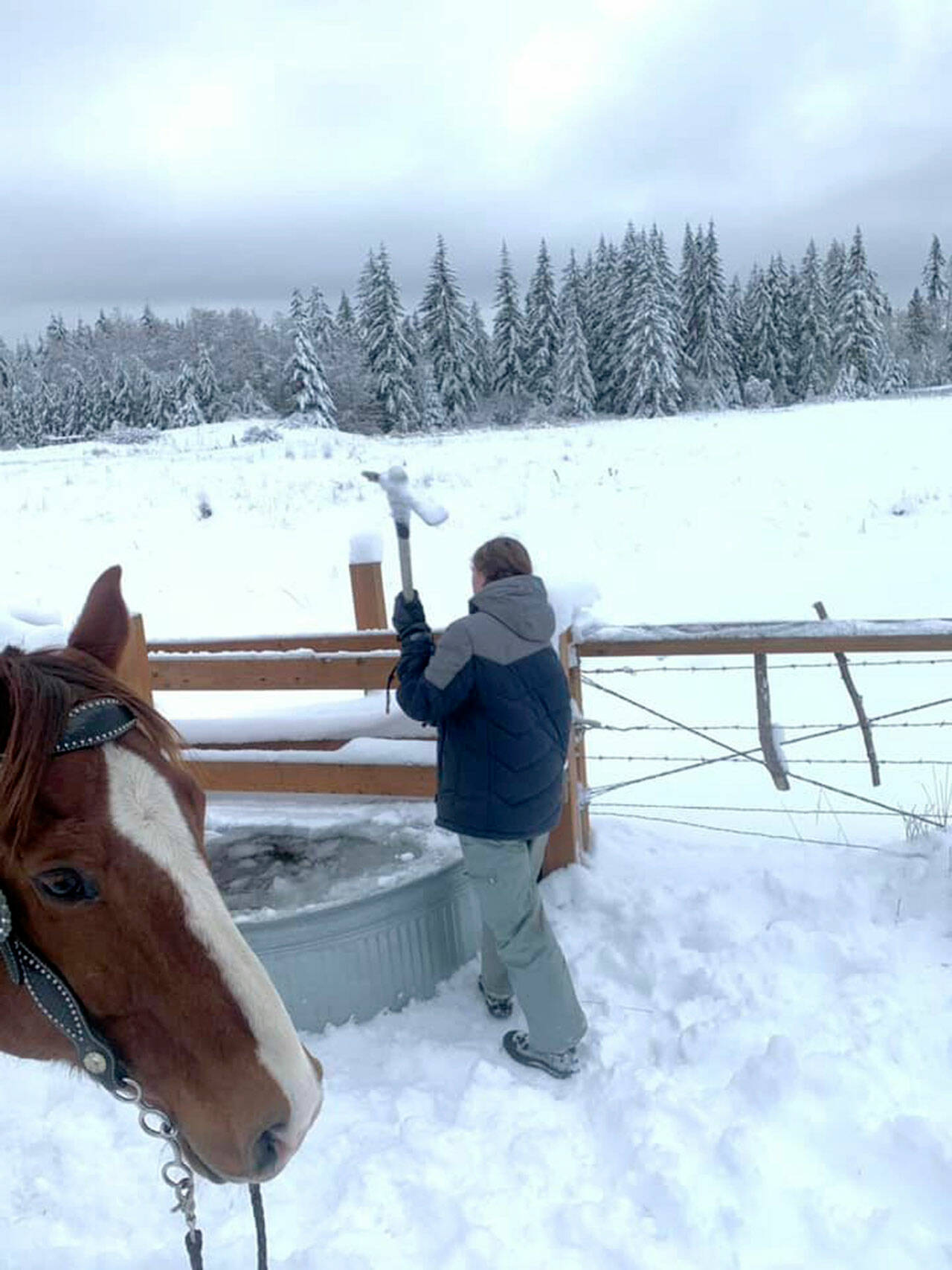CRUNCH, CRUNCH, CRUNCH. That was the sound I heard as through the snow I trudged. A twice-daily task it was to feed hay to my horses, to fill their desire to munch.
Ah yes, I am so glad the snow is an infrequent visitor where I live in Sequim because it makes outdoor tasks, such as taking care of my beloved horses, so much more of a chore.
Prior to going out in freezing temperatures, I climb into my insulated overalls, don my Bog boots, hat, insulated shirt, parka and insulated gloves. I wear so much to keep me warm that it becomes difficult to move. Ah well, at least I’m warm.
When I looked at my Facebook feed, I saw a picture of Jennifer Bond’s daughter Lillian, 13, riding her horse bareback through the snow. It reminded me so much of watching my niece Brooke at her age, jumping on her Welsh pony Gold to ride bareback in the snow.
And just as Brooke did back then, Lillian is active in junior rodeo, competing in the junior high division of Washington State High School Rodeo.
Lillian’s main events are barrels, poles, goat tying and breakaway roping. Her family is also active in the Back County Horsemen.
“Lillian is quite the trail rider and loves high mountain adventures,” Jennifer, a proud mom, said.
I love it!
Winter riding tips
Jennifer works as a conservation planner at the Clallam Conservation District. She offers these winter riding tips:
“We like to ride bareback when it’s cold and dry as it seems to help keep us warmer.
“In cold weather, we dress in layers and use base, insulating layers under our riding clothes. We’ve used both synthetic and wool blend layers and have had the best luck with using lightweight fabrics that are used by skiers and hunters.
“We have heated vests that we wear under our winter jackets on longer rides. The vests really help keep our core warm so we can ride longer without getting cold.
“We feed our horses extra hay during the winter to help keep them warm and ensure that all our stock tanks are heated. Dehydration is a leading cause of colic, and horses are more likely to drink heated water rather than freezing water.
“Lillian and I are both very busy, so we try to simplify getting ready for winter riding by keeping all our winter riding gear together in one spot. This makes it easy to quickly dress and head out for a ride. I have a ‘winter drawer’ where I keep long underwear, base layers, gloves, hats and my riding clothes. We both use down jackets for dry, cold weather and use waterproof outer layers if we’re riding in wet weather or snowy branches/brush.
“We do blanket our horses in the winter, mostly for our own ease, so we can quickly tack up dry, clean horses for a winter ride.
“One of my favorite winter riding accessories is my Jet Boil. This backcountry camp stove is small, portable and lightweight and will boil water in 60 seconds. We keep it in our winter trail bag, along with hot cocoa and instant coffee and plastic mugs. We can easily stop at any time and fix up a hot drink during our ride.
“Just like my winter riding clothes, I try to keep all my winter riding gear in one spot. I always carry a hand saw, first aid kit, extra hat, gloves and socks and a few snacks (protein bars, beef jerky and dried fruit). I do my best to keep this all packed up, so I just have to grab saddle bags and go.”
Blankets and deicer
Most young and healthy horses do just fine in cold weather as their double-layered coats act as an insulator; however, Lacey and Sunny are older now (Lacey’s almost 30) and have some arthritic joints, so both are enjoying the extra protection and warmth of wearing waterproof mid-weight blankets.
If you don’t have a stock tank deicer, then you’ll need to break the top of the ice on water troughs so horses have access to drinking water.
During cold weather, horses need more fuel in the in the form of good quality high-fiber hay, so, in addition to giving them their usual rations, I fill a slow-feed hay net they can nibble on when hungry. And year-round, they have mineral and salt blocks next to a water trough to lick as needed.
I hate slipping and falling on ice, don’t you? About 15 years ago, I discovered the best anti-slip product. It’s called Tyre-Grip Black Ice Protection. I spray it on my tires, the bottom of my boots and shoes, hoof boot treads, horseshoes and around the bottom of the hoof rims when they’re shoeless. It’s amazing stuff, and I’ve never understood why local stores don’t carry it. No need to buy a separate can of shoe grip because it’s the same product.
I buy it by the box from the manufacturer at tyre-grip.com. It’s available through other online markets, too.
Karen Griffiths’ column, Peninsula Horseplay, appears the second and fourth Sunday of each month.
If you have a horse event, clinic or seminar you would like listed, email Griffiths at kbg@olympus.net at least two weeks in advance. You can also call her at 360-460-6299.

